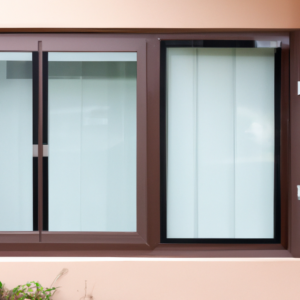Double glazed windows, also known as insulated glazing or thermal windows, consist of two glass panes separated by a layer of air or inert gas. This design significantly improves the window’s insulating properties compared to traditional single-pane windows. The primary goal of installing double glazed windows is to enhance energy efficiency, reduce noise infiltration, and maintain a comfortable indoor environment.

Double glazed windows
- Definition of Double Glazed Windows: Double glazed windows are windows that feature two glass panes with a gap between them to improve insulation and energy efficiency.
- Importance of Energy-Efficient Windows: Energy-efficient windows play a crucial role in reducing energy consumption, lowering utility bills, and decreasing the carbon footprint of households.
Benefits of Double Glazed Windows
- Improved Insulation: The air or gas-filled gap between the glass panes acts as a barrier, reducing the transfer of heat between the inside and outside of your home. This insulation helps maintain a consistent indoor temperature and reduces the need for excessive heating or cooling.
- Energy Efficiency: By minimizing heat loss in winter and heat gain in summer, double glazed windows help create a more energy-efficient home, leading to potential cost savings in the long run.
- Noise Reduction: Double glazed windows can significantly reduce external noise pollution, providing a quieter and more peaceful living environment.
- Condensation Control: The insulated design of double glazed windows reduces the likelihood of condensation forming on the interior surface, preventing issues such as mold and mildew growth.
Types of Double Glazed Windows
- Framed vs. Frameless: Double glazed windows come in various framing options, including uPVC, aluminum, and timber. Homeowners can choose the one that best suits their style and budget.
- Low-E Coating Options: Low-emissivity (Low-E) coatings can be applied to the glass to further enhance energy efficiency by reflecting heat back into the room.
- Gas Filling Options: The gap between the glass panes can be filled with inert gases such as argon or krypton, which have higher insulating properties than air.
Choosing the Right Double Glazed Windows
- Evaluating Energy Ratings: Look for windows with high energy ratings to ensure maximum efficiency and savings.
- Considering Window Styles: Double glazed windows are available in various styles, including casement, sliding, and awning windows. Choose the style that complements your home’s architecture.
- Selecting Glazing Options: Different glazing options are available, including clear, tinted, or textured glass. Consider your privacy and aesthetic preferences when making your selection.
Double Glazed Window Installation
- Professional Installation Importance: Proper installation is crucial to ensure the effectiveness of double glazed windows. Hiring a professional installer is recommended.
- DIY Installation Tips: If you have the necessary skills and experience, you may consider a DIY installation, but exercise caution to avoid any mistakes.
Maintenance of Double Glazed Windows
- Cleaning and Care: Regular cleaning of the window frames and glass helps maintain their performance and appearance.
- Troubleshooting Common Issues: Learn how to identify and address common issues like drafts or condensation to keep your double glazed windows in top condition.
Costs and Savings
- Initial Investment vs. Long-term Savings: While double glazed windows may require a higher initial investment, the long-term energy savings can make them a cost-effective choice.
- Government Incentives: Some regions offer incentives or rebates for installing energy-efficient windows, which can further offset the cost.
Environmental Impact
- Reducing Carbon Footprint: Energy-efficient homes contribute to reducing greenhouse gas emissions, making them more environmentally friendly.
- Sustainable Materials: Many double glazed windows are manufactured using sustainable materials, supporting eco-friendly practices.
Enhancing Home Aesthetics with Double Glazed Windows
- Design and Customization Options: Double glazed windows come in a wide range of designs and sizes, allowing homeowners to choose windows that match their interior and exterior design preferences.
- Window Dressing Ideas: Explore various window dressing options, such as curtains, blinds, or shutters, to enhance the visual appeal of your double glazed windows.
Comparing Double Glazed Windows to Other Window Types
- Single-Glazed Windows: Highlight the significant differences between single-glazed and double glazed windows, emphasizing the superior insulation of the latter.
- Triple-Glazed Windows: Discuss the pros and cons of triple-glazed windows and how they compare to double glazed windows.
- Tinted Windows: Explain the benefits and limitations of tinted windows and how they differ from double glazed windows.
Case Studies: Double Glazed Windows in Melbourne
Highlight real-life examples of homeowners in Melbourne who have installed double glazed windows and share their experiences and feedback.
Conclusion
In conclusion, double glazed windows offer a range of benefits that contribute to energy efficiency, comfort, and sustainability. By choosing the right type of double glazed windows and ensuring proper installation and maintenance, homeowners can create a more pleasant living environment while reducing their energy consumption and carbon footprint. Embracing energy-efficient solutions like double glazed windows is a step towards a greener and more eco-conscious future.
